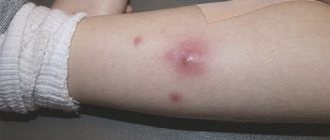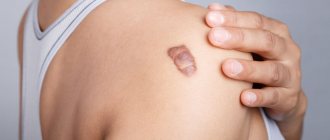Skin xerosis is an abnormal dryness of the upper layer of the skin caused by changes in the hydrolipid balance of the skin. It manifests itself as a dry, rough structure of the surface of the skin. The skin becomes cracked, inflamed, and infected. With the disease, the entire spectrum of pathological skin changes is observed: disturbances in sebum secretion, sweating, skin lipids, amino acid deficiency, and a feeling of discomfort. The condition is constantly accompanied by itching, which reduces the patient’s quality of life.
Causes
The main mechanisms for the development of dryness and flaking of the skin are a violation of its acid-base balance, poor functioning of the sebaceous glands, too frequent renewal of the upper layer of the epidermis and moisture deficiency in the epithelium.
The reasons may be: external influences, various diseases - both dermatological and general, and the general condition of the body. Of the external factors that have an adverse effect on the skin and cause dry skin, the most significant are the following:
- exposure to aggressive substances;
- chapping, hypothermia or overheating of the skin (for example, a sauna);
- improper skin care;
- exposure to ultraviolet radiation, especially in combination with weathering, or prolonged contact with an alkaline environment (for example, staying on the beach by the sea);
- regular exposure to hot or extremely cold water, especially chlorinated water.
Dry and flaky skin can be symptoms of the following diseases: allergic reaction; acquired, hereditary or congenital skin diseases, including psoriasis, seborrhea, eczema, atopic dermatitis, ichthyosis; diseases of bacterial, viral, inflammatory, hereditary and other etiologies. Dry and flaky skin may indicate the presence of: endocrine diseases (hyper- or hypofunction of the thyroid gland or adrenal glands, diabetes mellitus); problems with the digestive tract (gastritis, duodenitis, cholecystitis); metabolic disorders; some neurological ailments (migraine, autonomic-vascular dysfunction, neuralgia, neuroses, depression); damage to the endocrine system and other diseases requiring treatment. The most common cause of the development of xerosis is poor nutrition and, as a result, a lack of minerals and vitamins in the body. Spring peeling of the skin, often mistaken for an allergy, is in fact most often a manifestation of a lack of vitamins in the body. It is dull, dry and flaky skin that in most cases is the first symptom of vitamin deficiency A, E, B1 and C. Interestingly, a deficiency of vitamin B6 manifests itself on the contrary, with oily skin prone to acne formation. Dry hand skin may indicate a lack of vitamins A, E, B7 and D. Dry and flaky skin can also be caused by a lack of minerals (zinc, magnesium) and Omega 3 (polyunsaturated fatty acids).
Complications
The main complication of the disease is the appearance of skin and visceral (internal) malignant tumors. Multiple warty neoplasms have the highest risk of oncogenic transformation. The incidence of malignant tumors also correlates with the severity of skin pathological processes. With the early onset of the disease and its aggressive course, oncological tumors appear in adolescence (12-14 years) and quickly metastasize to internal organs.
Among malignant tumors, squamous or basal cell carcinoma most often develops, and melanoma of the skin or eye is the least common. Cases of more than 50 different types of oncology have been described: fibrosarcomas, angiosarcomas, histiocytes and others.
The disease can also lead to severe deformities of the face (mouth, nose, ears). The result is social maladjustment of the child and psychological problems.
Symptoms
Most often, dry skin is a temporary problem that only bothers you during a certain season, but it can last a lifetime. Symptoms of xerosis depend on your general health, age, where you live, and how much time you spend outdoors. Possible symptoms include:
- Feeling of tightness of the skin, especially after a bath.
- The skin is wrinkled and dehydrated.
- The skin looks rough instead of smooth.
- The itching is disturbing, sometimes very intense.
- Peeling of the skin - from slight to severe.
- Cracks in the skin, sometimes bleeding and painful.
- Redness of the skin, usually in limited areas.
Diagnostics
A detailed history taking is of great importance in making the correct diagnosis. The collected data (onset of the disease in early childhood, seasonality of symptoms, high photosensitivity, consanguineous marriages) suggest xeroderma pigmentosum. The diagnosis is confirmed after cytological and histological examination of the affected areas of the skin.
Additional examinations include examination by a dentist, otorhinolaryngologist, ophthalmologist and neurologist to exclude damage to the central nervous system, oral apparatus, visual and hearing organs. For De Sanctis-Cacchione syndrome, an X-ray examination or computed tomography of the skull bones, and magnetic resonance imaging of the brain are also performed. In this case, small sizes of the sella turcica, a decrease in the volume of the cranium and brain, and underdevelopment of the cerebellum and pituitary gland are detected.
Treatment
Methods for moisturizing the skin are different and are largely determined by eliminating the source - the catalyst of the problem. If the cause is a specific disease, then treatment of dry skin of the body includes all the necessary measures that can stop the pathology, and hence remove its accompanying symptoms.
If the reason is different, then it is necessary to take measures to protect the skin from the negative influence of external irritants, which can be eliminated independently. It is necessary to keep the skin clean, but you should not overdo it with the amount of washing and taking baths and showers. Cosmetics for washing must be of high quality and match your skin type. You should use only high-quality, non-expired cosmetics. In winter, it is necessary to use protective creams. In everyday life, prefer clothes and shoes made from natural materials. This will protect against the occurrence of allergic reactions to artificial material and protect against thermal overheating of the skin. Anti-inflammatory agents must be used along with moisturizers. It is recommended to use anti-allergy medications or general health-improving medications internally, which will be prescribed by your dermatologist.
Kinds
Depending on the damaged chromosome, there are 8 subtypes of the disease: A, B, C, D, E, FG and Young's pigmented xerodermoid. The first 7 types of xeroderma pigmentosum have a similar clinical course and are determined only after molecular genetic analysis. Young's xerodermoid pigmentosa has a more favorable prognosis - the symptoms of the disease appear later, and the pathological process itself is mild.
An independent clinical form of the disease is De Sanctis-Cacchione syndrome. It is considered the most aggressive type of xeroderma pigmentosum and is characterized by pronounced changes in the central nervous system. The syndrome can develop with any chromosomal variant of the disease, but most often occurs with subtype A.
Forecast
The quality and length of life depend on several factors, primarily on the timing of seeking medical help, making the correct diagnosis and early initiation of comprehensive treatment. With timely diagnosis of the disease and constant dynamic monitoring by a dermatologist or oncodermatologist, the prognosis is relatively favorable.
With warty growths on the skin, about 35% of patients do not survive to adulthood and die at the age of 13-15 years. This is due to the high tendency to malignancy and rapid metastasis of the tumor to internal organs.
De Sanctis-Cacchione syndrome has a poor prognosis. The aggressive course of the disease leads to death from oncopathology in childhood in 70% of patients.
Book a consultation 24 hours a day
+7+7+78
Folk remedies
Below are several recipes that will help you cope with the initial stages of xeroderma.
In addition, we recommend using these recipes during the cold off-season, when skin health especially needs support.
Bath "Cleopatra"
Ingredients:
- Fresh warm milk - 4 tbsp.
- Natural liquid honey - 0.5 tbsp.
- Warm olive oil - 5 tbsp.
How to prepare: Mix all ingredients. Pour the mixture into a bathtub with water at a comfortable temperature.
How to use: Lie in the healing liquid for 15-20 minutes. Dry your body with a soft towel without rubbing. Apply a cream with a restorative and moisturizing effect, for example, La Roche Posay, which is often recommended by dermatologists.
Result: You will be able to notice an improvement in skin condition after the first procedure. When you take such a bath every day, you will forget about the problem with xeroderma forever.
Hot compress for face
Ingredients:
- Mint petals.
- Calendula flowers.
- Linden blossom.
How to prepare: Take equal parts of the ingredients, pour boiling water over them, cover the container and wrap it up. Let the mixture sit for 10 - 15 minutes.
How to use: Soak a soft towel in the herbal infusion, cooled to a comfortable temperature. Apply to your face for 1.5 - 2 minutes. Repeat the procedure 5 - 6 times. Lubricate your skin with a nourishing cream; the Riche Desalterante cosmetic product has proven itself well in this regard. (Clean 2 times a week).
Result: The compress expands and cleanses pores, removes peeling.
Stages of disease development
There are 4 stages of development of xeroderma:
- It is practically asymptomatic. The person does not notice any structural changes in the skin (there is no wrinkling or itching), slight dryness is felt only on the feet.
- Over time, the skin begins to peel , thickens, becomes rough and hard. The patient constantly feels tightness of the skin. Begins to notice that from time to time itching and redness appear in certain areas of the body.
- Excessive exfoliation is observed. Painful cracks appear on the skin. Inflammation, itching and redness occur. In deep wounds, pus forms.
- This stage is characterized by a strong change in the structure of the affected skin. Trophic ulcers form (heal for a long time). The disease affects not only the protective layer of the skin, but also the dermis, which contains elements (elastin, collagen) responsible for the firmness and elasticity of the skin.
For reference: Symptoms of the first and second stages of xeroderma can be removed with the help of a deeply moisturizing cream, for example, such as “Losterin”. The third and fourth stages of pathology development require specialized treatment, including the use of medicinal antimicrobial and restorative drugs (see list below).
Xerosis of the scalp
A particular manifestation of xeroderma is xerosis of the scalp, the causes and treatment of which are determined by the doctor.
In most cases, this is caused by hormonal imbalance. In second place is incorrectly selected skincare products.
Before going to the hospital, you should try to solve the problem yourself:
- Change the shampoo to a softer one - sulfate-free. Or resort to washing your hair with hair balm. The latter should not contain silicones.
- Skip the hairdryer. And other devices and instruments that injure the hair and scalp.
- Drink more water. To replenish the body's lack of moisture.
- Use moisturizing masks for the scalp. Sold in a pharmacy.
And also take into account general advice on the treatment of xerosis.
Culture[edit]
Because people with XP need to strictly avoid sunlight but can go outside at night, they are called children of darkness
,
children of the night
and
children of vampires
. These terms may be considered offensive. [32]
XP has been a plot element in several works of fiction. One common theme in XP movies is whether teens with XP risk exposure to the sun in search of a romantic partner. [33]
Films such as Children of Darkness
, a German silent drama film that was released in two parts in 1921 and 1922 respectively, was among some of the initially popular films made about XP.
Other films, like the 1964 American drama film Dell
, starring Joan Crawford, Paul Burke, Charles Bickford and Diane Baker, directed by Robert Gist, which was originally produced by Four Stars of Television as a television pilot for a proposed NBC series called
Royal Bay
, which was also based on this skin condition.
Dark Side of the Sun
, a 1988 American-Yugoslav drama film directed by Bozidar Nikolić and starring Brad Pitt in his first-ever role as a young man searching for a cure for his disorder.
"The Others" (2001 film)
, a 2001 American psychological horror film starring Nicole Kidman, features two children, Anne and Nicholas, who must avoid sunlight due to a rare disease characterized by photosensitivity.
CBS television film aired in 1994, Children of Darkness
, was based on the true life story of couple Jim and Kim Harrison, whose two daughters are HR. [34] [35]
In Lurlene McDaniel's young adult book The Way I Love You
tells the story "Night Vision" in which the protagonist, leukemia survivor Brett, falls in love with a girl named Sheila who has XP.
Christopher Snow, the main character of the trilogy
Dean Koontz's
Moon Bay
, has experience and therefore must live most of its life at night.
The first two entries in the trilogy, Fear Nothing
and
Seize the Night
, were published in 1998.
The final entry in the trilogy, tentatively titled Ride the Storm
, has not yet been published as of August 2022. [36] [37]
2011 French drama film Moonchild
is based on a 13 year old child with XP which prevents him from being exposed to daylight.
2012 documentary Sun Kissed
explores the problem of XP on the Navajo Indian Reservation, and links it to the genetic legacy of the Navajo Long Alley when the Navajo people were forced to move to a new location. [38] [39] [40]
2022 romance film Midnight Sun
, based on the 2006 Japanese film
A Song to the Sun
, tells the story of a girl named Katie Price who has life-threatening sensitivity to sunlight due to XP and the impact her disease has on her normal life, which ultimately takes her away life due to neurological degeneration.
Xerosis in children
The causes of skin xerosis in children are different, and treatment depends on their nature.
So, the causes of skin xerosis in children may be as follows:
- allergy;
- endocrinological disorders;
- weak immunity.
In most cases, all this is transmitted with genes. To identify the cause, it is worth visiting the appropriate specialists.
It is acceptable to use special children's cosmetics. For example, moisturizing and soothing creams. Sometimes the doctor may prescribe medications.
To combat the scourge on their own, parents can be recommended to use “improvised” measures. This will improve the condition of the child’s skin texture (examples of skin xerosis in children photos).
- start hardening (if there are no contraindications);
- instill a love of hygiene;
- improve nutrition (fresh natural foods, more vegetables, eating at the same time);
- establish a routine (wake up and go to bed at the same time every day);
- ensure healthy sleep (8-9 hours a day, in absolute darkness, in a pre-ventilated room);
- get interested in sports (for example, enroll in some sports section).
Regular spending time outdoors will also benefit your growing body. However, it is better to avoid active sun.
In general, skin xerosis in children is similar to that in adults, regardless of the cause, so the approach to therapy is similar.











